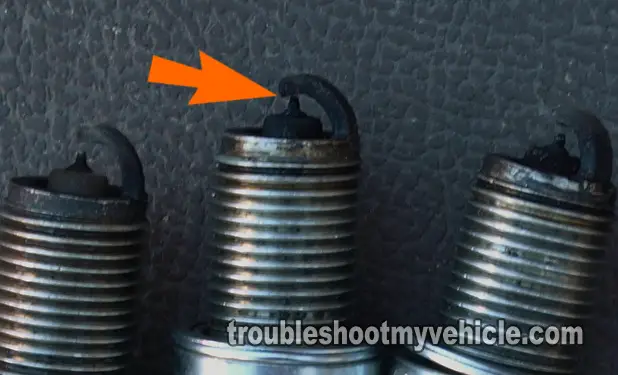Checking The Condition Of The Installed Spark Plugs

Now that I knew that the ignition coil was indeed sparking, the next test was to remove the #3 cylinder's spark plug and check its condition. I needed to check for two specific things.
The first was to see if the spark plug's porcelain insulator was cracked. When this happens, the spark jumps to the side of the spark plug tube (well), instead of being channeled to the center electrode. The end result of this condition is a cylinder misfire.
This is a very common problem that's usually caused because:
- The spark plug's ceramic insulator broke/cracked during the tightening process.
- The spark plug was dropped and the ceramic insulator cracked.
- The spark plug was bought that way.
The second thing I needed to confirm, was that the spark plug's gap wasn't closed and thus preventing the spark from jumping across the air gap.
This usually happens because:
- The spark plug was dropped.
- The spark plug was bought that way.
- The spark plugs weren't gapped.
As I was starting to remove the spark plug, I asked him if he had gapped the spark plugs and if he had dropped any on the floor during their installation, to which both questions he answered “No”.
I took out the #3 cylinder spark plug and as I was inspecting it, I found that the Ground electrode's gap was completely closed. Here was the cause of the misfire! (the photo in the image viewer is the actual photo of my buddy's spark plug)
After finding out that the #3 spark plugs outer electrode's air gap was closed... I ended up removing the other 3 to check their condition. The other 3 were OK.
Solution To The Misfire: Gap The Spark Plugs
My buddy couldn't believe it! He'd been pulling out his hair and spending money on parts his Corolla didn't need over something so simple!
Now, my buddy couldn't remember if he dropped the spark plug, as he was installing it or if it already came like that. Not only that, since the spark plugs were brand new, it never occurred to him that they could be the cause of the misfire.
Moral of the story? If the misfire (or any other problem that wasn't there before) starts after you've replaced something/anything, you need to double or triple check your work.
The source of the ‘new’ problem, that wasn't there before, is in what you just got done replacing (either due to a defective part or human error on your part).
Other Tips And Suggestions
Doing a tune-up on your Toyota with a 4 cylinder isn't hard. Keeping in mind the following suggestion will help:
- Buy a Japanese spark plug.
- Denso spark plugs.
- NGK spark plugs.
- Gap the spark plugs.
- If the valve cover is leaking oil onto the spark plugs...
- Replace the valve cover gasket and the spark plugs.
- If the spark plug and ignition coil boot are swimming in a lot of oil, you may need to replace the ignition coil too.
- If you don't know how much to torque (tighten) the spark plugs, use a torque wrench.
More 1.8L Toyota Diagnostic Tutorials
You can find a complete list of 1.8L Toyota tutorials in this index:
Here's a small sample of the tutorials you'll find in the index:
- How To Test The Ignition COP Coils (1998-2008 1.8L Toyota Corolla).
- How To Test The Fuel Injectors (1998-2008 1.8L Toyota Corolla).
- How To Test The MAF Sensor (2003-2008 1.8L Toyota Corolla).
- How To Test Engine Compression (1993-2008 1.8L Toyota Corolla).

If this info saved the day, buy me a beer!

